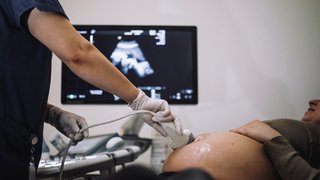What to do when pregnancy becomes a pain in the tailbone
November 10, 2020

Many women experience lower back pain during pregnancy. For approximately one-third of pregnant patients, the aching annoyance becomes a significant pain in the rear – or more precisely, the tailbone.
The tailbone, or coccyx, sits at the bottom of your spine, above your tush and behind your uterus. It helps stabilize you when sitting and serves as an attachment point for the pelvic floor muscles that support your bladder, bowel, and uterus.
While approximately 70% of women experience low-back pain at some point in their lives, 50% - 80% report back pain in pregnancy. For nearly 10% of them, the pain can be debilitating.
Tailbone pain is often caused by the pelvic ligaments loosening and shifting. During pregnancy, your body releases a hormone called relaxin. The hormone makes your pelvic ligaments looser and more flexible to make room for the baby to grow and enable you to give birth.
This can cause tighter contraction of the pelvic floor muscles, which help stabilize the body. The pelvic floor muscles are connected to the tailbone, leading to pain.

As your abdomen expands, your center of balance is altered and your posture shifts, adding pressure in the low-back and tailbone, which typically aren't weight-bearing. Your growing baby may also begin to put pressure on the tailbone, making sitting and standing painful.
Additionally, issues such as constipation or not getting enough exercise can also contribute to tailbone pain.
While we may not be able to cure tailbone pain, there are steps you can take to ease derriere discomfort. I’ve invited my colleague, Rupali Kumar, M.D., from UT Southwestern’s Physical Medicine and Rehabilitation (PM&R) team, to discuss ways to ease tailbone pain during pregnancy.
Related reading: 5 weird pregnancy symptoms you might not know about
How to take pressure off your tailbone
Tailbone pain is more common in the late second trimester and third trimester, and while you can’t entirely avoid it, there are things you can do to get relief.
Pay attention to your posture
You may have a tendency to slump forward or overarch your back while pregnant, but that can eventually take a toll on your spine. Make sure you are sitting upright with your feet flat on the ground. Engage your core with your back just slightly curved and your neck straight.
Balance and symmetry are especially important during pregnancy, when so many ligaments are loose. Don’t cross your legs, step out of bed with one leg, or put your pants on while standing up and putting one leg in at a time. These types of asymmetric movements can exacerbate tailbone pain.
Being in the same position for a long period of time can also make pain worse, especially when sitting, so make a point to get up and move around frequently.

Use special pillows
You can take some of the pressure off your achy tailbone by using a special seat cushion. While you might immediately think of a donut pillow, we find that it can sometimes create pressure in other areas. Instead, we recommend a wedge-shaped cushion with a cutout for the tailbone region.
You also might want to consider grabbing an extra pillow when you sleep. Put it between your legs to position your hips and knees in a more comfortable neutral position.
Take a pain reliever – with your doctor’s permission
While we always try to limit medication during pregnancy, there are a few options that may help relieve tailbone pain. This includes topical numbing patches, acetaminophen (Tylenol), or a muscle relaxant such as Flexeril.
As always, check with your Ob/Gyn before using any over-the-counter or prescribed medications.
Related reading: Know the risks of taking ibuprofen, NSAIDs during pregnancy
Try to avoid getting constipated
The tailbone and rectum are in close proximity. Unfortunately, pregnancy hormones can increase the risk of constipation, and iron supplements can slow the digestive system. Drinking lots of water, staying active, and eating high-fiber foods can help keep things moving and prevent pain.
See a physical therapist
If your pain is severe or other interventions are not quite doing the trick, a physical therapist may be able to help. Our goal is to reduce muscle tension while preserving muscle strength and correcting the instability that causes the pain.
We will create a personalized plan for you that may include stretching and breathing exercises that can help relax the pelvic floor muscles and improve their length. We may fit you for a belt or brace to help stabilize the pelvis. Therapy may also include manipulation of the tailbone and myofascial release of the pelvic floor muscles that anchor onto the tailbone, from both internally and externally, which can further reduce muscle tension and pain.
Related reading: 5 exercises and techniques to train for childbirth
Will tailbone pain improve after childbirth?
For most women, tailbone pain subsides soon after delivery. Unfortunately, sometimes the instability caused by loose ligaments during pregnancy and the trauma of delivery can cause ongoing tailbone pain and postpartum pelvic floor dysfunction.
If over-the-counter medication and physical therapy do not help, some people may benefit from injection of corticosteroids. We try to avoid these injections during pregnancy because they are generally guided by fluoroscopy, an imaging technique that uses X-rays.
Related reading: Body after birth: Treating post-pregnancy problems
Only in the most severe cases, your doctor may recommend surgery. This likely would not be considered until after delivery, and only if the more conservative treatments do not help.
We have plenty of options to reduce pain and make you comfortable. There is no reason to suffer, so if the pain lingers or worsens, talk to your doctor about next steps.
To visit with an Ob/Gyn or physical therapist, call 214-645-8300 or request an appointment online.










